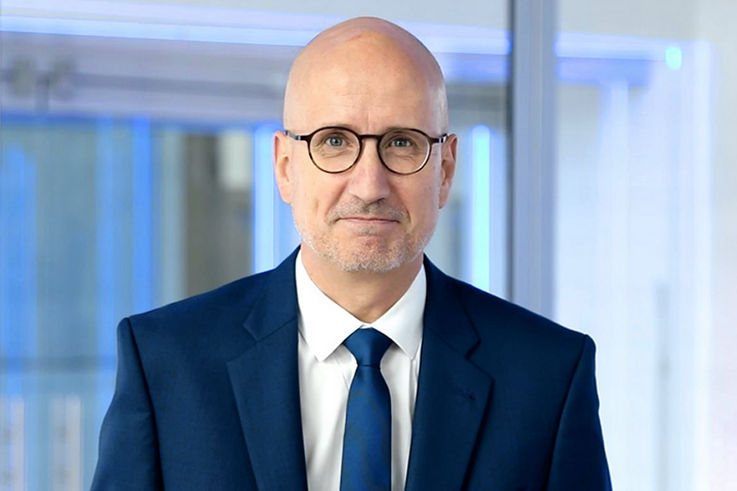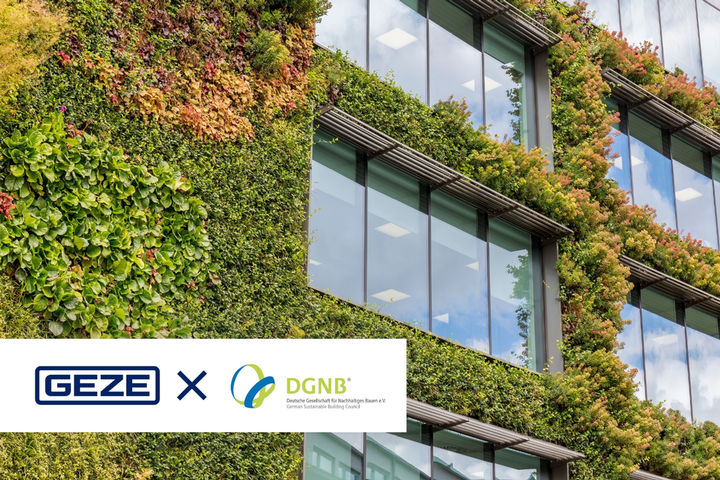Sustainable building – with long-standing DGNB member GEZE
The future belongs to sustainable building – but numerous economic, ecological and social aspects must be taken into account. This makes the planning and implementation of new and existing projects complex. It's good to have an expert at your side who has an excellent network and is always up to date thanks to membership in the German Sustainable Building Council (DGNB).
The European Green Deal in the construction industry

The DGNB now has more than 2,500 members from the construction and property industry who share their expertise and work together on an interdisciplinary basis in the interests of sustainable building. As one of the largest CO₂ emitters, the construction industry has a particular responsibility to drive forward sustainable structural change in line with the European Green Deal.
The high importance of the topic is also reflected in the sharp rise in the number of DGNB certifications in 2022. The DGNB system – established in 2009 by leading experts in the German construction and property industry – awards certificates and honours to sustainable buildings and districts. The previous record number of 1,424 certified projects was reached in 2022. But that's not all: 2,711 additional projects were registered for certification as at 31 December 2022 – an increase of almost 25 percent. The path to greater sustainability in construction is therefore on a steep upward trend.
Climate-neutral continent by 2050

Peter Rürup, Teamlead PM Standards, explains the importance of CO₂ in the construction industry. © GEZE GmbH
The construction and property industry is thus following the guidelines of the European Green Deal, which states that Europe should be the first continent to be climate-neutral by 2050 at the latest. However, greenhouse gas emissions are to be reduced by 55 per cent already by 2030 – in Germany by as much as 65 per cent, as stipulated in the new Climate Protection Act. "It is therefore inevitable that the construction industry, with its particularly high CO₂ emissions, will also face significant changes and requirements. CO₂ will become a new currency in building practice and a key criterion for all future investments and tenders", says Peter Rürup, Teamlead PM Standards at GEZE.
New guideline from 2027: the Global Warming Potential
From 1 January 2027, a new key figure defined by the EU will apply to new buildings with more than 2,000 m2: the Global Warming Potential (GWP). This is calculated from the greenhouse gas emissions contained in the building products and from the emissions generated during the use of the building over its entire life cycle. The GWP value can be used to recognise the global warming potential of a substance and thus its contribution to the warming of the air layer near the ground, the greenhouse effect.
From 2030, the GWP value will be mandatory for all new buildings, regardless of their size in square metres. The exact limit amount has not yet been determined, and the EU member states can also set their own limits.
It is therefore inevitable that the construction industry, with its particularly high CO₂ emissions, will also face significant changes and requirements. CO₂ is thus becoming a new currency in construction practice and a key criterion for all future investments and tenders.
Peter Rürup, Teamlead PM Standards at GEZEThe requirements for sustainable building are growing

Drives and controls from GEZE for sustainable building. © Exorbitart / GEZE GmbH
Pleasing to see: The large increase in DGNB certifications shows that the topic has truly arrived as a point of concern in the industry – and that the decisive criteria for sustainable building are already being laid down in the planning phase. Architects are faced with a number of challenges. In order to fulfil the increasingly complex sustainability requirements – both from a legal and client perspective – they must find customised, competitive solutions.
As a long-standing DGNB member, GEZE has the necessary expertise in the field of modern, sustainable construction. We provide support with excellent technical expertise and a wide range of products and solutions right from the planning phase – both for new buildings and for refurbishments.
Criteria and advantages of DGNB certification

The Kö-Bogen II with Europe's largest green façade and the Dreischeibenhaus are impressive landmarks in Düsseldorf's city centre. © Jürgen Biniasch / GEZE GmbH
The DGNB bases its sustainability approach on a three-pillar model. In relation to the topic of "building", the three pillars can be briefly described as follows:
- Economy: Buildings should be planned and operated in such a way that they can be used in the long term.
- Ecology: Buildings should be constructed in a way that conserves resources and protects the environment, with the lowest possible CO₂ footprint.
- Social: The users of the building should be at the centre of planning – in terms of their health, comfort and well-being.
In addition to the DGNB, which has already certified buildings in more than 20 countries, there are other international sustainability certifications for the construction industry, such as BREEAM from the UK or LEED, a certification system for ecological construction from the U.S. Green Building Council. All take certain sustainability criteria into account when assessing buildings, but weight them differently. However, the advantage of DGNB certification is that the organisation applies the requirements of the criteria to the respective region, for example specifically to the German construction sector – something that the other certification systems do not achieve to the same extent.
Read more about green building
Nevertheless, the DGNB advocates harmonising the standards – an important prerequisite for achieving climate protection and sustainability targets in the construction sector. With its standardised certification system, which uses the important standards for each respective project, the DGNB already offers a suitable template. In addition, the DGNB's criteria go beyond the standards of other certification systems by expanding the concept of sustainability to include social aspects.
What is important in sustainable building?
As a planner, this is a question you must answer, so that buildings and building products fulfil the requirements of green building:
- In terms of sustainability, a building should have the longest life cycle possible. Building Information Modelling (BIM) helps you to visualise the complex construction processes in integral building planning using a digital model – from the planning phase through construction to operation. How long will individual phases last, and what building life cycle can you expect? All these questions are answered by BIM.
- Place value in the origin, quality and workmanship of the building material and all integrated products – only then can you rely on the longevity of both individual components and the building as a whole.
- What is the production chain behind the building materials you want to use? Only largely climate-neutral production is compatible with the requirements of sustainable building.
Ensure that the building is designed in such a way that energy-efficient utilisation is ensured. Smart building management systems, such as those offered by GEZE, are essential to doing so.
Sustainable refurbishment or new construction
Anyone considering replacing an existing, un-renovated building with a sustainably designed new building in order to fulfil all green building criteria should have a check carried out to determine which is the more sustainable option: renovation of the existing building or construction of a new building? "Regardless of which standard you use as the basis for your project, we must not forget that we have a building stock with a high number of emissions already built into it when it comes to all CO₂-reducing new construction measures", emphasises Dr Anna Braune, Head of Research and Development at the DGNB.
Renovation, not demolition
GEZE not only provides support for new construction projects, but also for building renovations when the aim is to renovate instead of demolish. Modernising façades is an important lever for meeting more sustainability criteria. GEZE offers a wide range of products for energy-saving ventilation technology with automated windows and doors.
Regardless of which standard you base your project on, with all CO₂-reducing new construction measures, we must not forget that we have a building stock with a high quantity of emissions already built into it.
Dr. Anna Braune, Head of Research and Development at the DGNB
The importance of EPD-classified products is increasing
EPD is short for Environmental Product Declaration. For Germany, the Institut Bauen und Umwelt e. V. has developed an EPD programme with building and environmental authorities. In an EPD, building products are assessed according to ecological criteria; the GWP value, i.e. the amount of greenhouse gas emissions of a substance, is also included here. Crucial for planners: The new Construction Products Regulation (BAUPV) recognises EPDs as part of the obligation to provide evidence. At GEZE you will already find a wide range of EPD-classified products, which we are continuously expanding.

The DGNB, GEZE and advantages for you
The German Sustainable Building Council (DGNB) was founded in 2007. GEZE became a member just three years later – so we have many years of expertise in the field of green building and can live up to our claim of sustainability in the construction and property industry. By regularly exchanging ideas with experts and other like-minded people in the DGNB network, we ensure we are always up to date with our expertise – which benefits you as a customer as well.
As a family-owned company with over 160 years of tradition, we not only look back on a long history of success, but also toward a future that we want to help shape sustainably: with liveable buildings in the spirit of responsibility for the environment, people and the region.
More about EDP products from GEZE
To the environmental product declarations (EPDs) at GEZE





